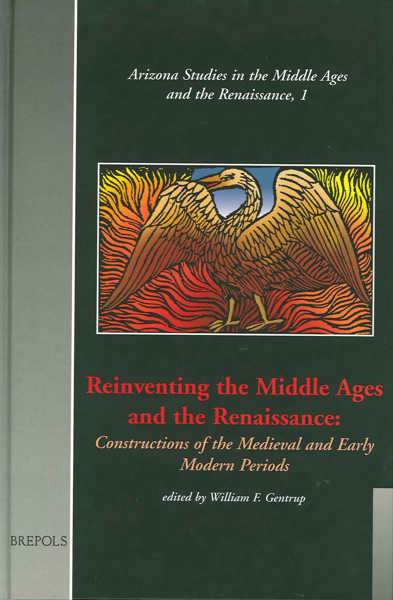
The Book of Nature and Humanity in the Middle Ages and the Renaissance
David Hawkes, Richard G. Newhauser (eds)
- Pages: xxvi + 322 p.
- Size:152 x 229 mm
- Illustrations:19 b/w, 2 tables b/w.
- Language(s):English
- Publication Year:2013
- € 95,00 EXCL. VAT RETAIL PRICE
- ISBN: 978-2-503-54921-7
- Hardback
- Available
- € 95,00 EXCL. VAT RETAIL PRICE
- ISBN: 978-2-503-54997-2
- E-book
- Available
The essays gathered here re-examine the boundary between the human and the natural world as it existed in the Middle Ages and the Renaissance.
"What the anthology does best (...), is engage with these critical approaches and show that scholars in the humanities have an important place in the discussion. (...) This commendable anthology should lead its audience to reflect that we contemplate a putative posthuman age within a fabric of intellectual, cultural, and technological developments medieval and early modern people could scarcely have imagined. And yet, seen from our own technological adolescence, the richness with which people centuries ago conceptualized humanity and nature illuminates their condition and ours as entangled with the physical world and prone to change." (Sean Cocco, in: Renaissance Quarterly, 67.3, 2014, p. 979-980)
"Il filo conduttore che aiuta nella lettura della varieta e diversita di contributi inseriti in questo “Libro di natura e umanita”, varieta come si e visto non solo di temi, testi e contesti trattati, ma anche di metodi di analisi, non e quindi la dicotomia in se fra uomo e natura, ma la ricchezza e la multiforme articolazione con cui tale dualismo fu concettualizzato, e puo essere oggi ricostruito ed esaminato. Vista in questi termini, l’eterogeneita degli studi qui raccolti giustifica la scelta operata dai curatori di aprire una molteplice possibilita di ricerca in prospettiva interdisciplinare nell’esame di questa articolata tematica, invece che offrirne una chiave interpretativa unitaria." (Cecilia Panti, in: Studi Medievali Ser. 3, 57, 1, 2016, p. 394-397)
Some modern commentators welcome the alleged approach of the “post-human” era as a liberation from the constraints of essentialist identity. Others lament it as a harbinger of the death of the soul. But both groups will find it instructive to consider that the nature of humanity has always been a contested topic. The chapters collected here suggest that the emergence of the modern idea of the human was at least as fraught a process as its putative demise.
David Hawkes and Richard G. Newhauser have selected a wide array of contributions for this volume. Renowned scholars from several disciplines have produced a series of fascinating essays, which concentrate on the relation between humanity and nature as it was understood in the Middle Ages and the Renaissance. The issues they examine range from poaching to flatulence, from Aztec animal symbolism to Jesus’s grandmother, from tulips to the Trinity.
Some chapters examine a wide variety of popular texts, from the bloody legend of Robert the Devil to the sinister magic of the Anglo-Saxon “wen charm,” from Lutheran Books of Nature to Emperor Maximillian’s wedding. The result is a book that raises intriguing implications for the modern struggle over the meaning of mankind.
Introduction: Boundaries of the Human - David Hawkes and Richard G. Newhauser
Landscapes
The Discovery of the Mountain as an Epistemological Challenge in the Late Middle Ages: A Paradigm Shift in the Approach to Highly Elevated Nature. With Particular Attention to Petrarch’s Ascent to Mont Ventoux and Emperor Maximilian’s Theuerdank - Albrecht Classen, University of Arizona
The Lutheran Book of Nature - Kathleen Crowther, University of Oklahoma
A Missionary Manual: Fray Bernardino de Sahagun’s Florentine Codex in Relationship to European Bestiaries - Laura Kilian, University of Oregon
The Human Body
Of Incontinence and Incontinentia: Women’s Flatulence in the Poetry of Rustico Filippi - Fabian Alfie, University of Arizona
Theodoric of York: Teaching Medieval Medicine and Natural Philosophy in the Modern Medical Curriculum (or: How I learned to Stop Apologizing for Teaching “Bad Medicine”) - Brenda Gardenour Walter, St. Louis College of Pharmacy
Root, Branch, and Flower: Lineage and Fecundity in the Versified Offices for St. Anne - Michael Alan Anderson, University of Rochester
The Body Politic
Crossing the Boundaries of the Civic, the Natural, and the Supernatural in Medieval and Renaissance Europe - William Bradford Smith, Oglethorpe University
Freiberg’s Tulip Pulpit: Hybrid Nature and Civic Politics - Guita Lamsechi, University of Toronto
The Animal Body
Poaching in Middle English Popular Romances - Jacqueline Stuhmiller, University of Wisconsin –Milwaukee
The Watchdogs of the Soul: The Role of Dogs in the Spiritual Salvation of Robert the Devil - Laurence Erussard, Hobart and William Smith Colleges
Archaic Magic of Wolf and Eagle in the Anglo-Saxon ‘Wen Charm’ - Marijane Osborn, University of California –Davis
Ethnoscapes
Issues of Humanity in the Rhetoric of Crusade Preaching - Charles W. Connell, Northern Arizona University
‘None Ends Where He Begun’: John Donne, Reformation Polemic, and the New Astronomy - Andrew Fleck, San Jose State University
Inside and Outside in Gisla saga Surssonar - Kendra Willson, University of California –Los Angeles
Index of Names and Subjects




